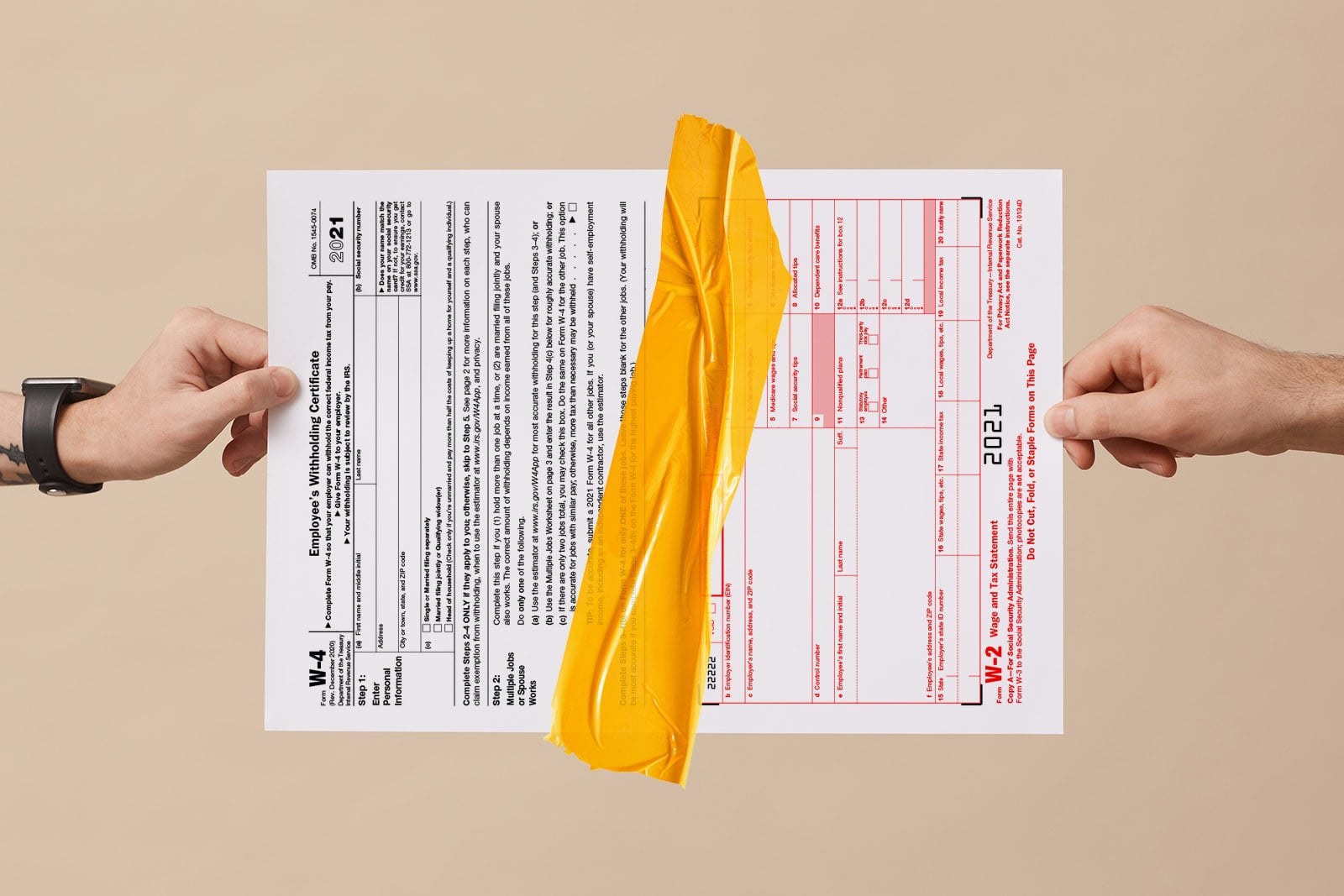W-4 vs W-2 Forms: A Definitive Guide for Employers

To avoid unwanted Internal Revenue Service (IRS) penalties, it’s important that employers complete W-4 and W-2 forms at the end of each tax year.
However, knowing what each form’s requirements are and the differences between them can be challenging. This is especially true for a small business without a large payroll department.
This article will explain why W-4 and W-2 forms are necessary, how to identify and complete each one, and what the options are for submitting them on time.
The basics of W-4 and W-2 forms
Once business owners know what W-4 and W-2 forms are, understanding their differences and filling them out becomes much easier.
Let’s take a closer look at the basics of each of these tax forms.
Form W-4
Also known as the Employee’s Withholding Allowance Certificate, the W-4 is a form that the federal government requires employees to fill out when starting a new job.
For an employer’s purposes, an IRS Form W-4 is used to determine the amount of income tax to withhold from an employee’s paycheck.
This amount will be based on the employee’s wage and the number of withholding allowances they qualify for.
It’s important that the information on the Form W-4 is accurate.
If the incorrect amount is withheld from your employee’s paycheck, they could face expensive tax bills or penalties at the end of the tax year.

Form W-2
This IRS form is also known as a Wage and Tax Statement. Employers are required to complete and distribute this form to their employees by the end of the tax year.
The W-2 form is a document that outlines how much an employee was paid during the year and how much income and federal tax was withheld.
For each employee that is paid at least $600 in wages, employers must file a copy of the Form W-2 with the Social Security Administration (SSA). This is the case even if no income, Social Security or Medicare taxes were withheld from the employee.
We’ll go into more detail about what these withholding allowances are later in the article.
This form should be submitted with your employee’s tax return. Otherwise, the IRS will not accept the tax return as valid.

W-2 vs W-4 forms: Knowing the differences
Now that you know what these IRS forms are, we can outline the key difference between Forms W-2 and W-4 and how they relate to business owners.
It’s crucial to remember that the main difference between these tax forms lies in their purpose and who fills them out.
What are the purposes of these forms?
Although W-4 forms are filled out by employees, they also have important implications for employers.
This is because the form outlines the necessary amount to withhold from an employee’s paycheck for tax purposes.
Employees must fill out a new Form W-4 whenever their financial situation changes. In addition to starting a new job, this could include a change in marital status, having a child or a pay raise.
All of this information is relevant to an employer because it could indicate a change in the employee’s payroll taxes at year-end.
An employer is only required to complete certain sections of the Form W-4 if their state has new hire reporting requirements.
Once the Form W-4 is complete, employers should keep this document in case the IRS requests a copy of it.

On the other hand, employers have the sole responsibility of completing Form W-2.
Not only is the W-2 form used to inform the government of how much tax has been withheld from each employee, but it can also be used for staff record-keeping purposes.
The W-2 form should outline the following information:
- The employee’s gross pay
- Any bonuses or tips the employee received
- Federal income tax contributions such as Medicare taxes
- Additional withholdings, such as contributions to retirement plans
All of this information needs to be collected by the employer to give the SSA and the IRS an indication of each employee’s income tax returns.
What is the deadline for submitting W-4 and W-2 forms?
Another difference between the W-4 and W-2 forms is their submission deadlines.
A general rule of thumb is that a W-2 form is to be completed at the end of the tax year and the W-4 form is filled out once by employees at the beginning of their employment.
Employers must complete and distribute the Form W-2 to their employees by January 31.
If this date falls on a weekend or a national holiday, the deadline will be shifted to the following business day.
Moreover, employers must also ensure that another copy of the W-2 form is filed with the SSA by the end of February.
An employee should ideally complete their Form W-4 during their onboarding process when starting a new job. This is because the form determines how much tax is withheld from their pay.
If an employee fills out a new W-4 form because their financial situation changes, this document should be submitted to the employer within 10 days.
The table below summarizes the differences between Forms W-4 and W-2:
| W-4 Form | W-2 Form |
| Employees fill out Form W-4. | Employers complete the form on behalf of their staff. |
| The purpose of this form is to inform employers of how much income tax to withhold from employees. | The W-2 form is used to report how much an employer-paid each employee and the amount of income tax withheld during the tax year. |
| W-4 forms should be submitted to employers within the first month of starting a new job. | Employers must complete and distribute a copy of the Form W-2 to their staff by January 31 of each calendar year. |
| Employers are recipients of W-4 forms. | W-2 forms are intended for employees and the IRS and SSA. |
| The Form W-4 is submitted each time an employee starts a new job or needs to report changes to their financial situation. | The Form W-2 is submitted only once, at the end of the tax year. |
How do employers fill out W-4 and W-2 forms?
IRS forms can be lengthy and intimidating at first glance.
However, if you know what information is needed to complete W-4 and W-2 forms, the process is much easier.
Form W-4
Employees that are single (or married to an unemployed spouse), have no dependents and claim only one income, only need to include the following information on an IRS Form W-4:
- Full name and address
- Social Security number
- Marital status
- The employment commencement date
The employer will then need to enter their full name, address and their Employer Identification Number (EIN).
Employees can also expect an additional three pages on the Form W-4. These include:
- The Personal Allowances Worksheet
- Deductions, Adjustments and Additional Income Worksheet
- Multiple Jobs Worksheet
If the employee has more than one job, a working spouse or dependents, filling out a W-4 form can be slightly more complicated.
Multiple jobs or a working spouse
Employees that have more than one job or whose filing status is “Married filing jointly” can complete their IRS Form W-4 in a few different ways.
If the employee has two jobs, or if the spouse and the employee each have one job, the first line of the “Multiple Jobs Worksheet” must be completed.
Both the employee and their spouse must ensure that they both fill out a W-4 form with their respective employers.
Employees with more than two jobs between themselves and their spouse have to complete sections 2 to 4(b) on the W-4 form for the highest paying job.
The W-4 form also comes with a worksheet to guide employees on how to use the salaries from their lower and higher-paying jobs to calculate the amounts to add to each line on the document.
Dependents
It’s important for employers to note that if their employees have dependents they may be eligible for the Child Tax Credit.
The eligibility requirements are that a single taxpayer must either be earning less than $200,000 or making less than $400,000 as a married couple filing jointly.
Employees would then multiply the number of dependents they have by the Child Tax Credit amount and add the amount to line three on Form W-4.
If the employee has other dependents, it’s their responsibility to review who the IRS considers as dependents to ensure this section is completed accurately.
Additional Withholdings
After employees fill out the essential information on their W-4 form, they can also specify if they want any other money withheld from their paycheck.
A good example is when an employee expects to earn income that is not subject to tax deductions. On the IRS Form W-4, these sections are:
- 4(a): This section should be completed if the employee expects to earn “non-job” income that is not subject to tax withholdings.
- 4(b): Employees should fill out this section if they expect to claim deductions and want to reduce their withholdings.
- 4(c): This section must be filled out to specify whether the employee has any other additional income they want to be withheld from each paycheck.
Before the employee can submit their W-4 form, they must sign and include the date to ensure the document is valid.
Form W-2
When employers fill out W-2 forms, they need to include the company’s name, address and state-specific tax number.
Additionally, the Form W-2 requires the following basic information about the employee:
- Full name, address, Social Security number
- Gross pay
- Federal Income Tax
- Social Security Tax
- Other compensation such as bonuses or tips
Although W-2 forms are fairly straightforward to complete, there are a few common mistakes which employers should avoid.
Not only can errors on the W-2 form cause confusion for employers and employees, but these mistakes can also be penalized.
Here are some of the most common mistakes to avoid:
- Filling out a W-2 form that is outdated and from the previous year
- Completing the form with incorrect employee name and Taxpayer Identification Number
- Using titles and abbreviations in the name fields of a Form W-2
- Missing the IRS filing deadline
- Not using black ink to fill in the form
- Omitting your EIN
- Failing to complete the employee’s “Retirement plan or Medicare wage” section.
Both employers and employees should ensure that the income tax withholdings on the Form W-2 are accurate to avoid expensive tax bills.
Taking a closer look at penalties
In the event a taxpayer does not fulfil their tax obligations, they could be subject to a penalty with the IRS.
This means it’s important for both employers and employees to be aware of the different types of penalties and how to avoid them.
There are a few reasons why penalties might be owed. Here are some of them:
- The taxpayer does not file their tax return on time
- Information on the tax return is incorrect
- The individual pays their tax return in the wrong way
The IRS may also charge interest on a penalty if the taxpayer does not pay the total amount. Additionally, it may charge some penalties every month until the full amount is paid.
When the IRS issues a penalty, they will inform the individual by letter or mail. This notice will outline the penalty, the reason for it and how to resolve it.
What happens after the W-4 and W-2 forms are filled out?
Once these IRS forms have been completed, the next step is to file them electronically or send physical copies by mail.
Let’s take a closer look at what each of these options entails and their pros and cons.
E-filing
This process involves filing tax returns over the internet via the Electronic Federal Tax Payment System (EFTPS).
One of the main benefits of e-filing is that it processes returns much faster than mail submissions.
Not only are returns processed within a day or two, but the IRS also sends people instant confirmation when their forms have been received.
With e-filing, there is also less chance of human error. This is because the IRS does not have to manually enter your return into the system.
The tax software used by the IRS completes the calculations, flags errors and will let taxpayers know if they have missed any important information.
Although e-filing is efficient, there are a few limitations. Individuals cannot use the e-filing system if:
- Additional statements or images are attached to the return
- The return is for someone who has passed away
- The IRS has not opened the filing system for the year
Paper filing
For those who prefer not to use technology, paper filing works just as well as electronic submissions.
This method also allows taxpayers to be much more thorough when completing their tax returns.
The paper filing gives the individual the opportunity to review all the details of their tax return and see the calculations first-hand.
Many taxpayers also find paper filing more secure because they do not have to upload any of their personal information onto the internet.
Although the IRS has security measures to prevent data breaches, paper filing has less chance of ending up in the wrong hands.

On the other hand, mail submissions take longer to process. Taxpayers can wait up to six weeks to receive refunds after their returns have been processed.
There is also a greater chance of errors in processing paper tax returns because the IRS manually transcribes data in the system.
Paper filing can also be quite daunting for beginners because various forms need to be gathered and submitted with the return.
Filing extensions
Whichever submission method you choose to use, it’s important to request a filing extension if you are unable to meet the deadline to avoid late penalties.
To request an automatic extension, taxpayers must use Form 4868.
The extension allows you more time to file your tax returns, but keep in mind that the tax payment is still due by April 18.
Say goodbye to W-4 and W-2 form guesswork
We know that the process of creating and filling out IRS forms can be overwhelming. That’s why our forms generator has been designed to be simple and easy to use.
This means that employers can easily produce, fill out and print W-4 and W-2 forms in a matter of minutes.
Using Form Pros also gives employers peace of mind that all IRS forms are filled with the correct calculations.
With our affordable subscription plan, employers can create unlimited W-4 and W-2 forms at a low cost. Click here to find out how to create tax forms in three easy steps with Form Pros.

Employee Is Hired by EmployerEmployer inputs employee info into the payroll system, including hire date and pay rate. |

Employee Completes IRS Form W-4Employer adds data into payroll system from employee’s W-4 Employee’s Withholding Allowance Certificate. |

Employee Works & Gets Paid During the YearEach pay period employer provides wages and deducts and pays taxes based on the W-4 withholding data. |

Employee Receives W-2 at Year EndOn or before Jan 31, employer provides IRS and all employees their year-end W-2: Wage and Tax Statement. |
We Can Help You!
- Saves time and headache
- Easy to follow steps
- Preview and share easily
- Preview pre-purchase